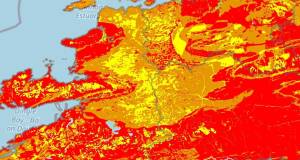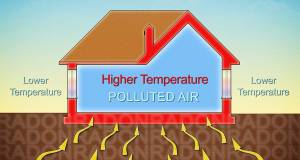- Radon
- Posted
Radon

The dangers of Radon and how Irish Industry must start to bear responsibility for it's employees
Up to 150,000 workers are at potential risk of developing fatal lung cancer as a result of exposure to dangerously high levels of radiation*, while a leading radon expert has cited ‘widespread confusion amongst employers’ regarding their legal requirements.
The onus Claffey places on risk assessment is reinforced in another letter to Higgins from Tom Beegan, CEO of the HSA, who stresses that ‘In relation to Radon, the risk of injury generated by exposure should be assessed. The risk is normally established by measuring Radon levels at a particular premises’.
Claffey further outlines the position for employers, saying that ‘If the presence of Radon gas is likely to occur in your workplace then you must assess the risk of injury from it’, a statement which demands further investigation.
‘Statements like this convince me that the lack of awareness, even on the behalf of some of the regulators, is alarming to say the least’, Higgins states. ‘Radon gas is present to some extent in (virtually?) every workplace in the country. Is Claffey inadvertently saying that every workplace in the country must be assessed?’
However, in spite of acknowledging that employers are obliged under the 1989 Act to assess radon levels, the HSA display a tendency to divert the issue from their own responsibility, a fact revealed in Beegan’s letter to Higgins:
Indeed, the RPII have been broadly accepted as the authority on radon in Ireland, and were behind the creation in 2000 of S.I. No. 125, the most widely known legislation on radon. In this legislation, employers face a legal obligation to assess radon levels in the workplace when so directed by the RPII. However, the only directions to date occurred in 2001, when the RPII sent letters to 3,000 companies in Ennis and Tralee. Less than 500 have complied in the 2 ensuing years, and there were no announcements of plans to prosecute the remaining 2,500 until July 7th of this year, when an article in the Irish Independent, drawing from an interview with David Fenton, manager of the natural radioactivity section of the RPII, revealed that the RPII ‘is preparing to take unprecedented legal action against employers in Counties Clare and Kerry because they are flouting directions to monitor radon levels’. The article was one of a series published at the time in national and regional papers, allied to features on regional and national radio, on the basis of press releases issued by Construct Ireland across the media.
As a result of this, and the fact that not a single prosecution has taken place to date, a belief has grown that the RPII possesses neither the resources nor the political will to enforce their own legislation. Indeed, this fact was reaffirmed for Donal Higgins in 2002, when RPII representatives at an IBEC hosted Radon Information Meeting in Tralee underlined their position in response to questions over employer’s general duties:
The response of the RPII officials at the meeting was that under S.I. 125 of 2000, there was no general duty on employers to assess the radon levels, that the RPII were only responsible for those employers that they directed, and that all other employers who did not receive direction letters might possibly have a general duty under general health and safety legislation to monitor their workplace. These therefore would fall under the responsibility of the Health and Safety Authority and not the RPII.
However, in his ongoing attempts to clarify the matter, Higgins received a letter from Renee Dempsey, the Principal Officer in the Nuclear Safety Division of the Department of the Environment, which attempted to ‘present the Department and the RPII’s agreed views on the matter […] based on our legal advice to date’. In this letter, Dempsey attempts to deal with the problems Higgins has found with S.I. 125:
‘The RPII does not and has not advocated an interpretation of S.I. no. 125 to the effect that the order only applies to those workplaces in respect of which a direction to measure radon concentration is given. In accordance with Regulation 3 2 (a) the order applies to work activities which “take place in workplaces having radon concentrations in excess of 400 Bq/m3”. The obligation to comply with the orders is, as the Chief State Solicitor puts it “in no way dependent on receipt of a direction pursuant to Regulation 30.”
Dempsey continues by stressing that ‘the specific legal obligation to measure radon in the workplace’ under S.I. 125 is only activated when a direction is ordered, although S.I. 125’s other regulations ‘apply once the radon concentration threshold is exceeded regardless of whether or not a direction has been given or indeed of whether or not anyone is aware of the radon concentration’. Therefore, employers may be in breach of these regulations, in spite of being unaware that radon is a problem at their premises. However, as Dempsey states, the fact that an employer has not been directed by the RPII ‘does not remove any legal responsibility from employers either under S.I. No. 125 or under Health and Safety legislation’.
The level of confusion that appears to permeate from a regulatory level down to employers should be addressed swiftly, according to Higgins. ‘I am now calling on all government departments, employer bodies, unions and regulatory authorities who have an interest in protecting the health and safety of workers to harmonize legislation in this area to deal with the widespread confusion that exists amongst employers’, he states.

In 1999 the RPII initiated a three-year programme with the Department of Education to measure radon levels in primary and post primary schools, resulting in assessments in 3,444 schools. 898 schools were found to have radon concentrations above 200 bq.m3 (the legal limit for children at school), and according to Conor Falvey of the Department of the Environment, ‘remedial works have been completed in a number of these schools’. According to research by Higgins, a large number of schools he has visited are well in excess of the legal limit, yet ‘the general comment from principals was that they were told there was no need to worry, as other schools were much higher, and they were simply recommended to open the windows as often as possible’.
The fact that insufficient resources have gone into raising awareness, enforcement, and remediation is recognised by Labour Party Spokesperson on Nuclear Safety, Emmet Stagg TD, who introduced grants for domestic remediation that were subsequently withdrawn by the Fianna Fail government.
‘I’m aware of the situation arising from the research Construct Ireland have drawn attention to’ explains Stagg, ‘and I’m calling for the Minister for Finance to provide the money, the Minister for the Environment to take the necessary action to do the assessments that are required, and to enforce the law, and I’m calling on the RPII to take the action against the companies that have defaulted the law.
Alarmingly, according to a senior government official, it is believed that there is an unwillingness on behalf of the government to put the necessary resources into dealing with the radon issue. Although many employers would doubtlessly prefer not to have to deal with the radon issue, Higgins stresses that enforcement of the regulations now, leading to assessments and remediation where needed, are ultimately in the best interests of the government, employers and employees alike. ‘Failure to act immediately will lead to continued exposure of workers to a real threat of premature death from a Class A carcinogen and in turn could open up the compensation flood-gates as workers sue both Government and employers over negligence in not enforcing the current legislation’.
*This research utilises the Radiological Protection Institute of Ireland’s national study of domestic radon levels based on 10 km squared grids, combined with CSO information on the numbers of workplaces in each grid.
Click here for an mp3 of our editor Jeff Colley taking part in a debate on Radon for The Right Hook on Newstalk 106fm.
Assessment Companies:
Radon Laboratory Services Ltd
Donal Higgins
Unit 6,
Carrick-on-Shannon Business Park,
Carrick-on-Shannon,
Co. Leitrim
Tel- 078 20724
Fax- 078 22873
This email address is being protected from spambots. You need JavaScript enabled to view it.
Mitigation Companies:
The Radon Barrier Company
Kevin Higgins,
Ballinagare,
Castlerea,
Co. Roscommon.
Tel - 0907 70782
Mobile- 086 224 0472
This email address is being protected from spambots. You need JavaScript enabled to view it.
Mid-West Radon
C2 Registered contractor
SEAMUS EGAN
8 Abbeyview,
Ballaghaderreen,
Co Roscommon.
Mobile 086 8341301
Fax 0907 60995
Email:This email address is being protected from spambots. You need JavaScript enabled to view it.
FF Systems
Liam Tinney
Lifford Road,
Castlefinn,
Co. Donegal.
Tel-074 46219
Fax- 074 46054
Mobile-086 833 2749
- dangers of Radon
- Radon
- potential risk
- Donal Higgins
- Radon Laboratory Systems
- radioactive gas
- Cancer
- Peter J Claffey
- presence of Radon
- health risk
Related items
-
 45,000 more Irish homes face radon risk, new maps reveal
45,000 more Irish homes face radon risk, new maps reveal -
 Poorly ventilated retrofits can double radon retrofit risk, study finds
Poorly ventilated retrofits can double radon retrofit risk, study finds -
 Radon in passive houses
Radon in passive houses -
 Landmark case may empower tenants on radon
Landmark case may empower tenants on radon -
 Passive homes may have lower radon levels — study
Passive homes may have lower radon levels — study -
 Government failing to act on radon in rented houses
Government failing to act on radon in rented houses -
Radon in groundwater

